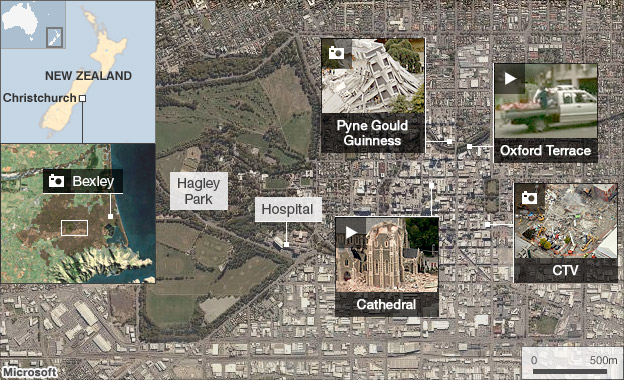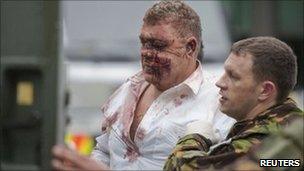New Zealand earthquake: Christchurch deaths rise to 75
- Published
Christchurch quake victims rescued from the rubble
New Zealand Prime Minister John Key has declared a national state of emergency as the death toll from Tuesday's earthquake in Christchurch rose to 75.
Police have said there is "incredible carnage right throughout the city", with "bodies littering the streets".
More than 300 people are still missing. Forty-eight were pulled out from collapsed buildings alive overnight.
The search has now been abandoned at one office block, but elsewhere a woman was rescued after more than 24 hours.
"The situation is that we don't believe this site is now survivable," said police area commander Inspector Dave Lawry near the remains of the Canterbury Television building. "It was a hard choice and my heart goes out to all the families."
He said rescuers now needed to concentrate their resources elsewhere in areas where survivors were more likely to be found.
About 100 people are believed to be inside. Earlier, the head of the fire service denied reports that 15 people trapped inside had been rescued.
The building housed a language school and Insp Lawry said some foreign students would be among the dead there.
At the Pyne Gould Guinness building, cheers were heard as office worker Ann Bodkin was pulled out alive on Wednesday afternoon, after being trapped for more than 24 hours, and reunited with her waiting husband.
The authorities have imposed a night-time curfew in the worst-affected areas of the city.
The earthquake struck at a shallow depth of 5km (3.1 miles) on Tuesday at 1251 local time (2351 GMT on Monday), when the South Island city was at its busiest.
It was Christchurch's second major tremor in five months, and New Zealand's deadliest natural disaster in 80 years.
CLICKABLE Select the images for more details.

Bexley

Streets in the north-eastern suburb of Bexley were flooded as the quake caused water mains to burst, which coincided with heavy rain.
Pyne Gould Guinness

The multi-storey Pyne Gould Guinness Building, which normally houses around 200 workers, collapsed. A number of people were thought to be trapped inside.
Cathedral

The 63m spire of the city's Anglican cathedral was toppled by the earthquake. A New Zealand TV reporter took a look inside the damaged building.
CTV building

Part of Christchurch's Canterbury Television [CTV] building completely collapsed in the earthquake. Some 24 people have been rescued from the building, but police said there might be between 60 and 120 bodies trapped underneath.
Oxford Terrace

In the aftermath of the earthquake, Rhys Taylor took this video on Oxford Terrace, 50 metres away from the city's main hospital. He said: "Cars were being used as ambulances to transport the injured."
Prime Minister John Key, who grew up in Christchurch, declared a national state of emergency after a cabinet meeting in the capital, Wellington. He said it would allow the greatest possible co-ordination of local, national, and international resources to work on rescue and recovery efforts.
He told residents of Christchurch that New Zealanders felt "your pain as only a small nation can".
"Things will get better. Christchurch will rise again," he added. "This country is right behind you and we are backing you with all of our might."
'Incredible carnage'
Mr Key ordered that the country's flag be flown at half-mast on all public buildings until further notice to honour the victims.
He said he he hoped that the city would still be able to host its allotment of games for the 2011 Rugby World Cup in September-October.
"It's a very important city to New Zealand and it would be a demonstration that Christchurch is back up on its feet."
More than 500 search and rescue personnel, police, fire service staff, soldiers and volunteers have been scrambling to find survivors trapped under the rubble, many using only their bare hands.
Christchurch's main hospital was inundated with people suffering head and chest injuries, a spokesperson said.
"There are bodies littering the streets, they are trapped in cars and crushed under rubble," Police Supt Russell Gibson said.
"We are getting texts and tapping sounds from some of these buildings and that's where our focus is," he added.
"It's quite amazing, we have some people we've pulled out and they haven't got so much as a scratch on them, we've had other people where we've had to amputate limbs to get them out."
The ministry of civil defence said 22 people alone were missing in Christchurch Cathedral, which lost its spire and a section of roof. Police say there has been no sign of life from underneath the rubble.
Twenty-four others have been rescued from the Pyne Gould Guinness building and dogs have detected another four or five still alive. The earthquake flattened the four-storey structure where hundreds worked.
'Total darkness'
One foreign student, 19-year-old Kento Okuda from Japan, had his leg cut off to allow his rescue from the CTV building.

Dozens of people have been rescued from the rubble
"As we were eating lunch, there was a major shaking, and suddenly the floor fell," he told Japan's Asahi Shimbun newspaper.
"Everyone around me was saying things like 'It hurts' as they fell downward," he said.
"And then I realized I was in total darkness, with my right leg pinned by something so I couldn't move."
Rescuers have also put a cordon around the city's second tallest building, the Hotel Grand Chancellor, because it is threatening to collapse.
Emergency shelters have been set up and schools have been closed until buildings are assessed for risk.
About 80% of people in Christchurch are without water, reports the New Zealand Herald., external
New Zealand experiences more than 14,000 earthquakes a year, of which only around 20 have a magnitude greater than 5.0.
Tuesday's was the country's worst natural disaster since a 1931 quake in Hawke's Bay on the North Island killed 256 people.
- Published25 February 2011
- Published23 February 2011
- Published22 February 2011
- Published22 February 2011
- Published22 February 2011
- Published8 September 2010